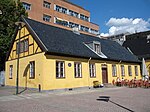National Internment Camp for Women in Hovedøya
1945 establishments in Norway1946 disestablishments in NorwayAftermath of World War IIBuildings and structures in OsloDefunct prisons in Norway ... and 6 more
History of women in NorwayNorwegian resistance movementWehrmachtWomen's prisonsWomen in NorwayWorld War II internment camps

The National Internment Camp for Women in Hovedøya (Norwegian: Statens interneringsleir for kvinner, Hovedøya) was Norway's largest internment camp for women, located on the island of Hovedøya in Oslo. It was used to detain women who had been accused of having romantic or sexual liaisons with German soldiers during World War II.
Excerpt from the Wikipedia article National Internment Camp for Women in Hovedøya (License: CC BY-SA 3.0, Authors, Images).National Internment Camp for Women in Hovedøya
German Bunker, Oslo Gamle Oslo
Geographical coordinates (GPS) Address Nearby Places Show on map
Geographical coordinates (GPS)
| Latitude | Longitude |
|---|---|
| N 59.894763888889 ° | E 10.729194444444 ° |
Address
German Bunker
0252 Oslo, Gamle Oslo
Norway
Open on Google Maps











